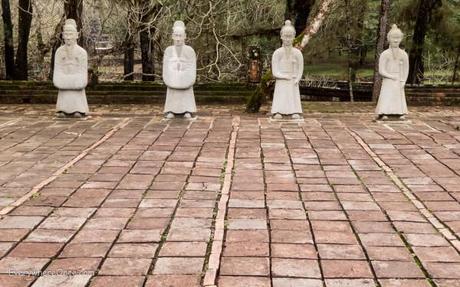
The Imperial City in Hue, Vietnam
If we waited for the sun to shine, we would never have seen the most impressive sites in Hue. While the rest of Vietnam has two seasons, rainy and dry, the central region surrounding this intriguingly historic city has its own: wet and wetter. Undaunted by the dire weather report for our five-day stay and eager to explore the royal realms of the Nguyen Dynasty, we armored up with newly-purchased plastic ponchos and umbrellas and set out into the mist.
The Imperial City

Gilded Dragon Standing Guard at the Imperial City
A walled palace and fortress, the Imperial City was the hub of power for the Nguyen emperors, Vietnam’s last royal dynasty, from 1802 until Ho Chi Minh’s forces took over in 1945.
The lavish city the Nguyen rulers constructed for themselves has largely fallen into ruin. Time and neglect contributed to its decline and so did being caught in the crossfire during the American-Vietnam war. And yet the Imperial City is still wonderfully atmospheric with its former grandeur shining through in places. Until the gentle “Hue rain” intensified enough to send us fleeing, we wandered around the sprawling, maze-like complex, taking whatever turn or walking through whatever doorway intrigued us the most.
Khai Dinh Tomb

If anything, an overcast sky enhanced the somber grandeur of Emperor Khai Dinh’s imposingly grand, multi-tiered mausoleum on the slope of Chau Chu Mountain. Construction on the royal’s final resting place began in 1920, four years into his reign.

With so many steps, visitors have to work hard to pay their respects to the departed Emperor. A set of stone stairs flanked by stone dragons leads to a second level adorned with statuary and sweeping views of the fog-shrouded hills. Make it to the top, and the payoff awaits—the gilded likeness of the Emperor, housed in an ornate stone building that makes for a great respite from the elements.
Tu Duc Tomb and Residence

The tomb that gets touted the most is that of Tu Duc, the “poet emperor,” and it was our second stop of the day after seeing Khai Dinh’s monument. He not only designed himself a mausoleum during his reign in the mid- to late 1800s, he made it part of a wooded lakeside retreat where he lived with his wives and concubines (he had more than a hundred!).

The complex is an interesting, tranquil place to explore, but we found it lacked the grandiosity of the Imperial Palace and the dramatic impact of Khai Dinh’s tomb.
Thien Mu Pagoda

Rising on the banks of the Perfume River, a waterway carving the city into two sections, Thien Mu Pagoda was overrun compared to the nearly deserted tombs further afield. A striking, seven-story structure, the “Heavenly Lady” is the tallest religious building in Vietnam.
Our Escape-the-Rain Sanctuary
When we wanted to watch the rain rather than walk around in it, we headed to the Gecko Cafe, where we returned again and again for the excellent coffee and even better service. During one of our java-drinking sessions, a waitress offered us something sweet on the side for the holiday season. “We have American gift for you,” she told us and then watched to see what our reaction would be to an adorable pair of reindeer cookies.

Rudolph and friend–almost too cute to eat.
Street Food with a Smile and a Side of Precipitation

Residents in Hue seemed to take the near-constant rain in stride. A typhoon-strength storm might alter the rhythms of the city, but otherwise we found it was business as usual. A light, intermittent rain didn’t keep a husband-and-wife duo from operating a sidewalk lunchtime business around the corner from our hotel–or us from sampling the fare they made in their makeshift kitchen. As they smiled and nodded at us, we pulled up tiny plastic blue stools to an equally diminutive table and feasted on steaming bowls of beef noodle soup. Comfort food for a rainy day.

